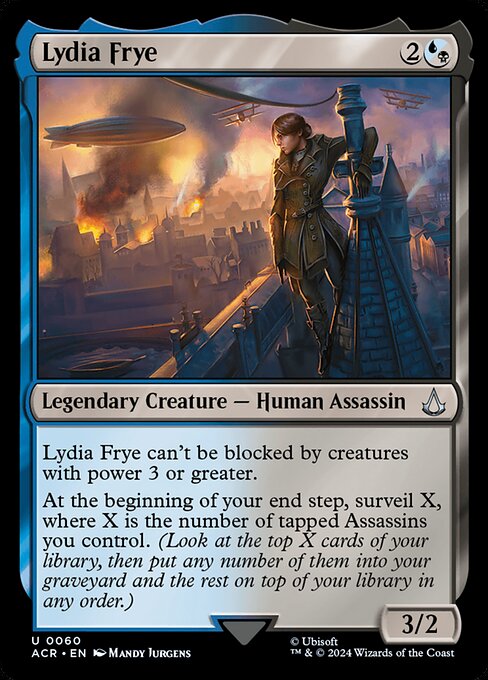
Image courtesy of Scryfall.com
Mapping MTG Card Relationships: A Closer Look at Lydia Frye's Network
In the sprawling tapestry of Magic: The Gathering, every card is a node in a larger web of interactions. Some cards quietly pull the threads—enabling surges of card draw, top-deck manipulation, or clever timing that shifts the tempo of a game. Lydia Frye, a Legendary Creature — Human Assassin from the Assassin's Creed crossover, embodies a particularly elegant kind of network logic. Her hybrid mana cost, unique blocking rule, and surveil-powered end step create a center that connects color identities, mechanics, and deck-building approaches in surprisingly rich ways. 🧙♂️🔥💎
Card fundamentals at a glance
- Name: Lydia Frye
- Set: Assassin's Creed (ACR) — a draft_innovation release that blends MTG with the Ubisoft universe
- Rarity: Uncommon
- Mana cost: {2}{U/B} (hybrid mana: either blue or black for the hybrid portion)
- Colors: Blue and Black (color identity: B/U)
- Type: Legendary Creature — Human Assassin
- Power/Toughness: 3/2
- Keywords: Surveil
Lydia Frye can't be blocked by creatures with power 3 or greater. At the beginning of your end step, surveil X, where X is the number of tapped Assassins you control. (Look at the top X cards of your library, then put any number of them into your graveyard and the rest on top of your library in any order.)
There’s a subtle geometry to her design. The blocker's vulnerability (or, rather, its clever denial) pairs with the end-step surveil trigger to reward a plan that leans on the count of tapped Assassins. This is not just a one-card engine; it’s a network signal—every Assassin you tap becomes a potential data point in your next draw sequence. And because Lydia Frye is a hybrid-identity creature, your mana base can tilt toward blue for velocity and card selection, or black for disruption and recursive plays. The result is a dynamic, tempo-friendly network graph that invites experimentation. 🎲
Why the surveil mechanic matters in a network graph
Surveil is a powerful way to tilt the information asymmetry in your favor. When Lydia Frye eyes the top X cards of your library, she’s not just digging for an answer; she’s revealing a flowchart of potential plays. The more Assassins you have that are tapped, the deeper the surveillance goes at end step. If you’ve already chained draw effects, fetch lands, or cycling strategies, the combination can cascade into advantage. The end result is a graph where each node (a card or a pile of cards) is connected via surveil triggers, with Lydia Frye acting as a central hub that rewards careful planning and precise timing. 🧠🔗
Practical network-building ideas
- Synergy with other surveil enablers: Pair Lydia Frye with other surveil tutors or cantrips to maximize the X in your end step. Cards that reveal or manipulate the top of your library create a feedback loop: you surveil, you draw or discard, you surveil again, and the graph grows denser with every turn.
- Tap mechanics and resource rhythm: Since X depends on tapped Assassins, include effects that tap or untap your board—without sacrificing tempo. Be mindful of the risk-reward: you want to push the surveil count without leaving Lydia Frye undefended against early aggression.
- Blocker dynamics: Her ability to evade creatures of power 3 or greater makes her a potent clock in creature-light or disruption-heavy matchups. In a deck built to protect her and keep the Assassin count flowing, she can sneak through for damage while fueling late-game recursion.
- Mana-splitting strategy: The {U/B} hybrid cost gives you flexibility. A blue-heavy shell can accelerate dig and selection; a black-heavy approach can leverage removal and discard to shape the battlefield and the library.
The network graph here is as much about psychology as mathematics. Opponents may be forced to respect Lydia Frye's evasive blocking and the looming end-step surveil, even if you haven’t yet revealed every card you’re about to draw. It’s a dance of information and timing—a hallmark of MTG’s best hybrid designs. 💃🧭
Artwork, flavor, and cross-pollination
The Assassin's Creed crossover injects a flavorful narrative into a color-minted strategy. Lydia Frye’s art by Mandy Jurgens captures a poised assassin’s gaze, a weaponized calm that mirrors the calculated graph you’re constructing on the battlefield. The merging of blue’s intellect and black’s shadowy tempo embodies the card’s identity: a bridge between two worlds that thrives on information, misdirection, and patient pressure. The hybrid mana symbol itself is a small but telling design flourish—two colors sharing a single cost, like two branches of a map converging on a single route. 🎨🗺️
Beyond the story, the card’s market stance is worth noting for collectors and players alike. With a price around modest ranges (nearby values show both nonfoil and foil options), Lydia Frye remains accessible for budget-conscious players while offering a surprisingly robust tactical toolkit for midrange and control builds. In a market that loves flashiness, this unassuming uncommon quietly rewards players who map out their own network of interactions. 💎
Cross-promotional note: utility beyond the table
While you chart a network of Assassin synergies and surveil-driven plays, consider keeping your gear ready for long tournaments, casual gatherings, or rainy days at the table. A rugged, protective phone case—like the Rugged Phone Case 2-Piece Shield (a two-piece, impact-resistant TPU/PC design)—keeps your device safe as you navigate rulebooks, decklists, and web articles about deck technology. The product page is a handy companion when you’re deep-diving into network graphs between rounds. 🔥
For readers who want to dive deeper into MTG’s evolving landscape, the following reads from our network offer complementary angles—ranging from blue-heavy saturation strategies to timeline reflections and ethical considerations in MTG speculation. Consider them as tangential branches that enrich Lydia Frye’s graph with broader context and insight.
Rugged Phone Case 2-Piece ShieldMore from our network
- https://blog.digital-vault.xyz/blog/post/dr3-tackles-saturation-for-a-blue-giant-at-two-kiloparsecs/
- https://blog.digital-vault.xyz/blog/post/where-restless-vinestalk-stands-on-mtgs-timeline/
- https://blog.rusty-articles.xyz/blog/post/efficient-tutors-to-fetch-revel-of-the-fallen-god/
- https://transparent-paper.shop/blog/post/texture-mapping-techniques-for-realistic-digital-paper-looks/
- https://blog.digital-vault.xyz/blog/post/rockfall-vale-and-the-ethics-of-mtg-speculation/